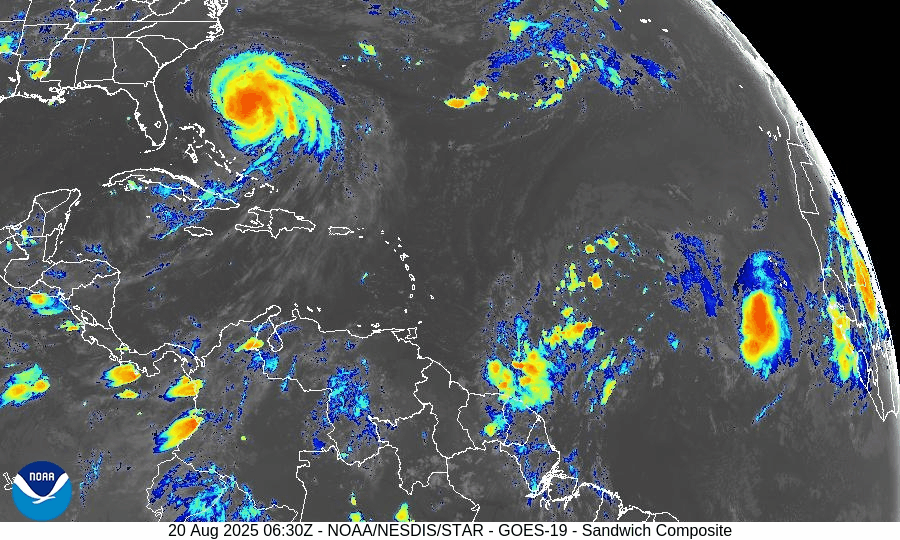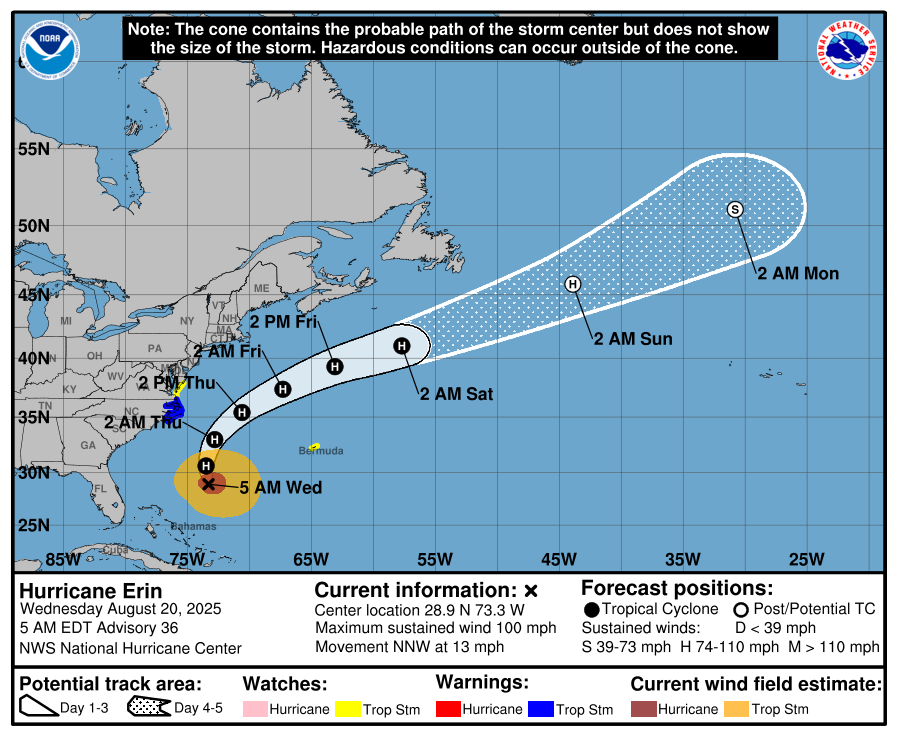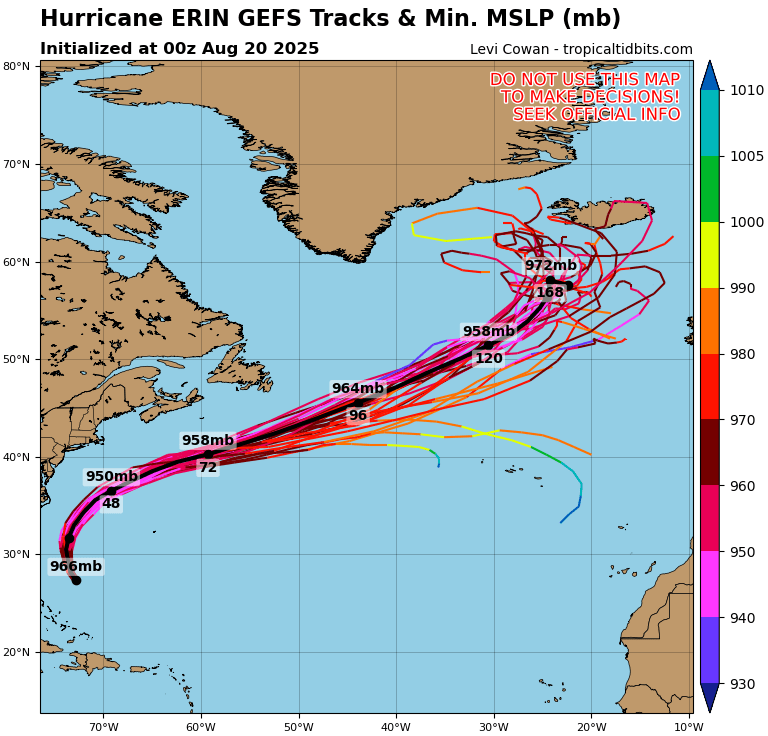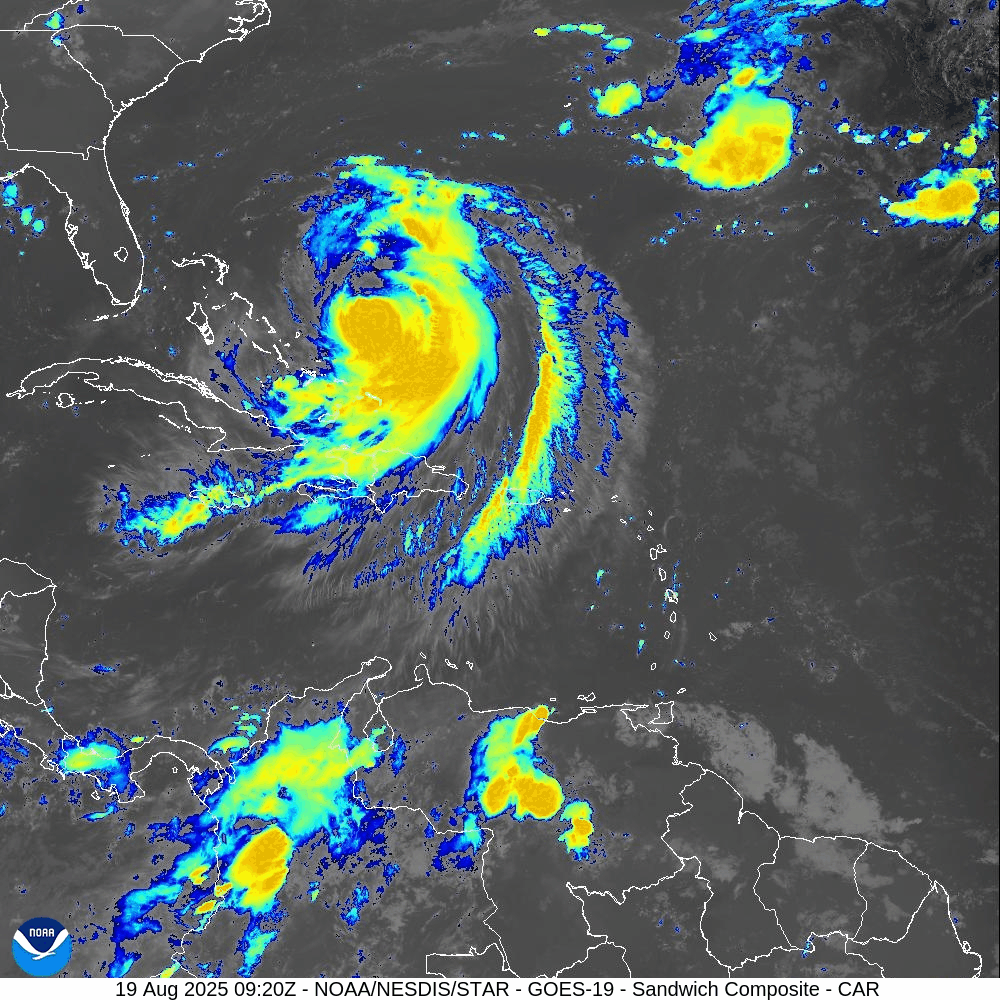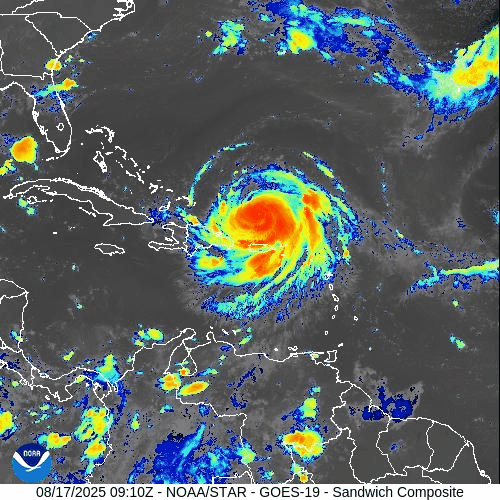Atlantic Hurricane Outlook – August 20, 2025: A Couple Systems In The Atlantic
Hurricane Erin is holding as a Category 2 storm offshore, producing rip currents and coastal hazards along the East Coast. Meanwhile, the Gulf and Florida remain quiet, though tropical waves in the Atlantic are being monitored.
TLDR Version: Click Here
Current Tropical Systems
Hurricane Erin:
Erin has weakened slightly but remains a Category 2 hurricane as it tracks northeast, well offshore of the U.S. East Coast. The storm continues to generate dangerous swells, rip currents, and pockets of coastal flooding, especially from the Outer Banks northward into the Mid-Atlantic and New England. While direct landfall is not expected, coastal impacts remain significant.Disturbance in the Central Atlantic:
A tropical wave near 45°W continues to show signs of organization. Environmental conditions feature warm sea surface temperatures but are partially offset by moderate wind shear and Saharan Air Layer (SAL) dust intrusion. Development chances: 30% over 7 days.Far Eastern Atlantic Wave (off Africa):
A fresh wave near 25°W is emerging with scattered convection. It remains disorganized but will be monitored as it progresses westward. Development chances: low (20% over 7 days).
Gulf of America (Mexico) Outlook
The Gulf remains broadly quiet, with high pressure dominating and keeping conditions mostly stable. While moisture pockets are leading to afternoon thunderstorms, there are no signs of tropical development at this time. Sea surface temperatures are very warm (29–31°C), so the region will continue to be monitored closely heading into late August.
Florida Forecast
Florida remains under the influence of high humidity and afternoon sea-breeze thunderstorms, typical for August. Outer rainbands from Erin are not expected to impact the peninsula. No immediate tropical threats are forecast for the state in the near term.
Rain forecast visualization courtesy of Windy.com
Key Environmental Factors
Sea Surface Temperatures (SSTs): 29–31°C across the Gulf and Caribbean, MDR slightly above average — supportive for development.
Wind Shear: Moderate over the central Atlantic, helping limit wave organization.
Moisture: Gradual increase in the western Atlantic, but SAL dust continues to suppress deep convection in parts of the MDR.
Outlook Summary
Hurricane Erin remains a strong offshore system, generating significant surf and rip currents along the East Coast.
Central Atlantic disturbance carries moderate development potential but faces shear and dust challenges.
Gulf of Mexico and Florida remain calm with no immediate tropical concerns, though warm waters warrant close monitoring later this month.
TL;DR
Hurricane Erin is now a Category 2 offshore system, still driving dangerous surf and rip currents up the East Coast. The Gulf of Mexico and Florida stay quiet with only scattered thunderstorms, while the central Atlantic wave shows some development potential but is being held back by wind shear and Saharan dust.
Atlantic Hurricane Outlook – August 19, 2025: Hurricane Erin holds as a powerful Category 3
Hurricane Erin remains a powerful Category 3 offshore system, bringing life-threatening surf, rip currents, and coastal flooding to the East Coast. Meanwhile, the Gulf of Mexico and Florida stay calm with no new tropical threats expected.
TLDR Version: Click Here
Hurricane Erin holds as a powerful Category 3; Life-threatening surf and flooding are poised to impact the East Coast
Hurricane Erin, now a Category 3 system with sustained winds near 115 mph, continues its path just east of the Bahamas. While a U.S. landfall remains unlikely, significant coastal impacts are unfolding. Meanwhile, the Gulf of Mexico and Florida remain calm.
Atlantic Basin Overview
Hurricane Erin (Cat 3): Sustained winds are approximately 115 mph. The storm remains offshore, shifted slightly northwest, and continues to drive dangerous surf and rip currents from Florida through New England. Forecasters warn of coastal flooding, storm surge, and beach erosion—especially across the Outer Banks, where evacuation orders are in effect. Waves are expected to reach 15–25 feet, with minor to moderate flooding along the Mid-Atlantic coast. Erin feels the effects of a prior eyewall replacement cycle and is now in a weakening trend influenced by increased shear and dry air.
Other Atlantic systems: No immediate new tropical cyclones are expected. The National Hurricane Center continues to monitor waves and disturbances, but environmental conditions (dry air, wind shear) remain inhibiting.
Gulf of America (Mexico)
Quiet and stable: There are no organized systems. Activity is limited to isolated afternoon convection along the Gulf Coast, tied to heat-driven storm patterns rather than tropical development.
Florida & Southeast U.S. Outlook
Florida Peninsula: Expect routine summertime weather—afternoon thunderstorms fueled by sea breezes. No tropical threats are anticipated.
East Coast (NC to FL): Erin's long-period swells are arriving along coastal areas, raising rip current and surf hazards significantly. Beachgoers must exercise caution, and lifeguard advisories should be strictly followed.
Rain forecast visualization courtesy of Windy.com
Environmental Conditions
Sea Surface Temperatures (SSTs): Remain warm—aiding Erin’s sustained intensity and surf generation.
Wind Shear & Moisture: Increasing shear and dry air are contributing to Erin’s gradual weakening and restraining new development elsewhere in the basin.
TL;DR – August 19 Snapshot
Erin downgraded to Category 3; offshore path continues; U.S. threats are limited to surf, rip currents, and coastal flooding.
Outer Banks under evacuation orders due to expected flooding and beach erosion.
Florida and Gulf: Calm, with routine afternoon storms and no new tropical systems.
Stay alert on the coasts: Dangerous marine conditions ahead—especially from North Carolina to Florida.
Atlantic Hurricane Outlook – August 17, 2025: Erin Got Big
Hurricane Erin briefly reached Category 5 strength but has since weakened to a Category 4 in the Atlantic. While multiple tropical waves remain active, dry air and wind shear are keeping them disorganized. The Gulf of Mexico sees lingering rain, and Florida continues with typical summer storms.
TLDR Version; Click Here
Current Status: Active major hurricane in the Atlantic
Hurricane Erin (Category 3, formerly Cat 5 then 4)
As of this morning, Hurricane Erin is holding as a Category 3 hurricane with maximum sustained winds near 125mph, after briefly reaching Category 5 intensity yesterday with peak winds of 160 mph.
Erin underwent rapid intensification in the open Atlantic but has since begun a gradual weakening trend due to slight increases in wind shear and internal structural changes (eyewall replacement cycle).
The storm remains over open water and poses no immediate land threat, but it continues to serve as a reminder of how quickly systems can ramp up when environmental conditions align.
Central & Eastern Atlantic
Multiple tropical waves continue to traverse the Main Development Region (MDR).
A wave near 35–40°W remains disorganized with only scattered convection.
Another wave just off Africa near 20–25°W is embedded in the monsoon trough, but Saharan Air Layer (SAL) dust and dry air should keep development limited in the short term.
Gulf of Mexico
Broad moisture and unsettled weather persists across the central and western Gulf.
No organized tropical system is expected, but localized heavy rain and thunderstorms may impact coastal Texas and Louisiana.
Upper-level conditions are not conducive for development at this time.
Florida & Southeast U.S.
Typical afternoon thunderstorms continue across the Florida peninsula, fueled by Gulf moisture and sea-breeze interactions.
No tropical threats are expected for the state today.
Rain forecast visualization courtesy of Windy.com
Key Environmental Factors
Sea Surface Temperatures (SSTs): 29–31 °C across the Gulf and Caribbean, with the MDR slightly above average — plenty of available fuel.
Wind Shear: Increasing in the western Atlantic, contributing to Erin’s weakening and suppressing MDR organization.
Moisture: Pockets of dry air and Saharan dust continue to limit development in the eastern Atlantic.
TL;DR
Hurricane Erin: Now a Category 3, after peaking at Cat 5 yesterday; remains over open Atlantic, no land threat.
Atlantic Tropics: Several waves, but limited organization due to dry air and shear.
Gulf of Mexico: Moisture lingers, rain possible, but no tropical development.
Florida: Routine summer storms, no tropical system expected.
CAT5Prep.com is staying on top of the storms. While Hurricane Erin may have passed the point of direct threat for many, there is more movement in the MDR (Main Development Region) of the Atlantic, and we all need to stay on our toes. The MDR is a critical area for tropical cyclone formation, and activity there often sets the tone for the rest of the hurricane season.

